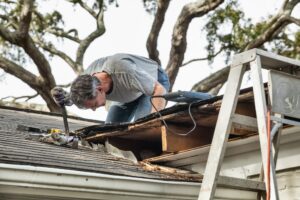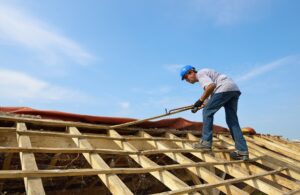When your home needs a roof replacement, you have two main options for how the roofers approach the task. One approach is for them to overlay the roof, which means they nail new shingles on top of the existing shingles. This is only possible with two caveats — the existing shingles are asphalt, and the roof hasn’t previously been overlaid. Most codes only allow for one overlayment.
The other approach is for the contractors to tear off the existing roofing all the way to the sheathing. They then install a completely new roof. Keep reading for the pros and cons of both approaches and how you can make your decision.
Cons of Overlay Approach
The main con of overlaying the roof that roofers bring up is that they can’t inspect the sheathing. Your roof could show no visible signs of damage yet have problems at the decking level. Small leaks can nonetheless delaminate plywood sheathing, cause boards to swell, and even create patches of rot.
A similar issue is that you can’t replace your underlayment layer. Many homeowners opt for underlayment upgrades at the time of re-roofing to address specific issues, such as ice dams.
The additional layer also adds weight to your roof. This additional weight is an issue if you have a large roof or get a lot of snow.
Finally, the underlying shingles will continue to deteriorate under the new layer. They may curl up and force the new shingles out of place. They may also decrease the lifespan of the new shingles and even void their warranty.
Pros of Overlay Approach
The main reason homeowners even consider an overlayment is cost. Because of the decrease in labor and materials, overlaying a roof is significantly less expensive. What’s more, you won’t have the added costs of shingle disposal.
Another benefit is that overlayment takes less time. You’ll have a shorter disruption in your life. Additionally, you have less risk of an event such as a sudden storm complicating the process. You also don’t have to deal with the falling debris from the tear-off.
Cons of Tear-Off Approach
The main con for the tear-off approach is cost. As alluded above, shingle removal costs both time and money. What’s more, you will have to pay for the upgrades if you decide on a special underlayment. Likewise, the length of the job will be longer, and you’ll have to put up with the falling debris.
Pros of Tear-Off Approach
The main advantage of the tear-off approach is you get a brand-new roof. Your roofers can inspect the sheathing and solve any issues on the spot. They can add an ice-and-water shield as underlayment to solve issues of ice dams.
You have other areas where you can upgrade, too. For instance, many roofers use OSB (oriented strand board) as part of the sheathing. OSB takes longer to get wet, but it also takes longer to dry. So, OSB is where you can see problems of swelling. Your roofer may suggest CDX plywood instead. You can also choose from any kind of roofing, not just asphalt.
Finally, a brand-new roof will last longer. You’ll be able to enjoy the warranty that comes with the materials and the installation. Your roofers can replace any attendant details, such as fascia, which will provide a much more attractive end result.
Overlay Versus Tear-Off Approach
Generally speaking, roofing experts only suggest the overlay approach for ideal circumstances. For example, if you have sound decking with no issues, an overlay may be beneficial. Likewise, a roof with no sidewalls where the flashing ties the shingles to the exterior walls of the house is another ideal situation because you’ll get a smoother transition.
Some roofing experts might also suggest an overlay as a temporary solution. Perhaps you plan to replace the entire roof in 10 years. An overlay of fresh shingles can tide you over until then. Just be aware that the tear-off job for two layers costs more in time and money.
If you’re ready for a new roof and don’t know which approach will work best for your situation, talk to Precise Roofing & Contracting.





